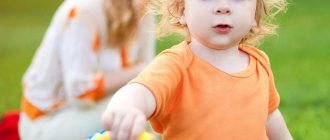Self-analysis on children's speech development
KGKP "Kindergarten-nursery No. 17 "Rucheyok" Self-analysis of the senior group No. 3 "Kapitoshki"
Prepared by: Educator: Onishchenko TA.
2021 Self-analysis on children's speech development.
The development of speech in preschoolers is one of the main tasks of preschool educational institutions. Therefore, creating a speech environment is one of the main tasks. Work on speech development can be seen in all types of children’s activities. That is why a well-established system of interaction between specialists is necessary: psychologist, speech therapist, physical education instructor, music director. The group has designed didactic games and manuals for the development of children’s speech, selected game material with visual games, reading fiction, speech finger games, and articulatory gymnastics. All this work is carried out in group and individual forms of interaction with children. We pay more attention to the development of coherent speech in children, taking into account their age characteristics, encourage children's word creation, try to encourage children to comment on their actions, and introduce them to the culture of reading works of fiction. The children in our group know how to use a variety of polite forms of speech and, together with an adult, make up stories based on pictures or toys. The greatest difficulty is in describing objects, pictures, naming signs, qualities, and expressing one’s own assessment. Our group has created all the conditions for the speech development of children. There is a book corner for children. The material in the corners is selected in accordance with the age of the children, the selection of books is carried out in accordance with the program requirements, we involve children in the work of “repairing” books, “providing help” to their favorite books. The group also has equipment for theatrical activities: flannelgraph, various types of theaters (puppet, finger, tabletop), etc. There are subject, subject pictures, material on familiarization with the surrounding world. During educational activities, I combine various forms of work: with the whole group and use an individually differentiated approach.
I also use the following methods and techniques: games, conversations, reading and memorizing texts of fiction, looking at illustrations, composing stories from pictures. Gaming
- surprise - creation of a game situation - an imaginary situation in expanded form.
Verbal
- conversation, conversation - questions - use of artistic words - reminder, explanation - teaching correct articulation - pedagogical assessment.
Practical
- performing finger and articulation gymnastics - modeling
Visual
- demonstration of aids - illustrative material I believe that the variety of equipment and materials used in the classes allows us to maintain the attention and cognitive interest of children throughout the entire lesson. In our classes, we try to create a situation of success for each child. Our communication is emotional. We actively use TRIZA elements (chains of words, composing fairy tales using diagrams), which contributes to the development of children’s mental activity. During classes we use problem situations and ask children questions of varying degrees of difficulty. We try not to forget that our speech is an example for children; it is necessary to formulate questions to children accurately, competently and clearly, and use them as one of the activating techniques. We monitor the emotionality and intonation expressiveness of our speech. We encourage children to give answers in complete sentences, and involve inactive children. We are planning the educational process: integrated classes are held, including sections on speech development, literacy training, and familiarization with fiction. During the classes, work is systematically planned aimed at solving problems in developing the sound culture of speech, forming the grammatical structure of speech, coherent speech, enriching the vocabulary, and cultivating interest in the artistic word. The solution to problems in speech development can be traced when planning educational work outside of class. We plan conversations with children on various topics, observations of natural phenomena, and examination of objects. work on inventing, asking riddles, working with materials from the book corner. Setting ourselves the task of enriching children's speech, we use a lot of additional material: · Visual and didactic material; · Individual cards, assignments, exercises; · Didactic games such as “Vegetables”, “Fruits”, “Seasons”; · Puppet show; · Observation and experimentation to understand the text; · Audio listening to fairy tales and poems; · Drawing up and use of diagrams - descriptions of objects; · Selection of finger games, facial exercises. By organizing your activities according to this section, it is not possible to achieve success in working with children without the help of parents. Therefore, we ask them to fill out a questionnaire on the topic “My child’s speech.” After analyzing the answers, we have information about the children’s speech at home, about when my pupil spoke, whether he likes to be read to, and what literary choices his mother makes. This material helps us think through work with the group as a whole, individually with each child and parents. They talk with the kids about the day in kindergarten, what new things they learned, consolidating the material received, consultations on what games are best to play at home with the child, reading fiction at home, meetings, consultations. There is visual information for parents on the speech development of children.
Are planning:
replenish the speech corner with modern aids and visual materials; continue to work on replenishing the speech environment; create a streamlined system of interaction with specialists. One of the important techniques for the development of children’s speech is the “Written Speech Situation”, when the child dictates and the adult writes down his text. It is this kind of exercise that helps improve the syntactic structure of sentences and prepares the child for the perception of written text in the future. I must say that I work in an older group, these are children from 4 to 5 years old. The kids really like to talk about the gifts they were given. The children gladly got involved in this situation, as everyone wanted to write about their gift. The guys' eyes sparkled, the group fell silent when someone spoke. The children understood that in the “written speech situation” they become the main ones, and the adult obeys the logic of their actions - this is a very acute experience. The children understood that I was interested in everyone, that before dictating, they should think about the statement. The children showed great interest in the result, when I read out their stories, the children said: “That’s what I said!”, the smile did not leave the children’s faces. This enhances the feeling of “transforming” the oral into the written. Even the inactive children found something to say, since the exercise caused the children’s speech activity. I arranged the children's stories in the form of folders - movements. Parents said that children ask to read again and again. Even if a child forgot something, on paper, in writing, his words were preserved. The children understood this. Parents responded positively to the stories written by their children. I suggested that parents write down their children’s stories at home about what was interesting in kindergarten. Not all of them, of course, but half of the group responded and took care of the children at home. The situation of written speech, organized in the family, is an excellent way to develop relationships between parents and children. I am pleased with the results of the work done. According to the testimony of Doctor of Pedagogical Sciences O. Ushakova, in the “situation of written speech,” that is, when a child talks and an adult writes down, children’s speech behavior changes. The child involuntarily begins to speak a little slower, phrases become longer, more detailed, words appear - connectives, additional definitions, common sentences. The child intuitively feels: written speech is more complex. “The situation of written speech” is an excellent tool for the development of oral speech, its complex form - monologue.



